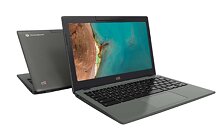
ASUS Announces Chromebook CZ Series Laptops
ASUS today announced the ASUS Chromebook CZ series of laptops tailored for K12 students, which offer a portable and durable design for enduring value and empower engaged learning - anywhere. Featuring a 180° lay-flat or 360°-flippable design and an 11.6-inch (CZ1104C/F) or 12.2-inch (CZ1204C/F) 16:10 WUXGA display or touchscreen with TÜV-certified eye-care technology, the series not only enhances the visual experience but also prioritizes eye protection. ASUS Chromebook CZ series laptops are built for easy IT maintenance, with a modular design that minimizes downtime. The series boasts an extended battery life for uninterrupted use throughout an entire day of classes, empowering students to extend their learning beyond traditional limits.
A reliable study companion
For K12 students, an everyday-use laptop should be invincible. With lively and active users, scratches and knocks are an almost-inevitable part of their daily routine, so the ASUS Chromebook CZ series features an all-round rubber bumper for extra peace of mind. The laptops also feature a rugged design that's tested to meet or exceed the MIL-STD-810H US military-grade standard, and use tough Corning Gorilla Glass to protect the screen from scratches. Additionally, the spill-resistant keyboard can cope with minor water spills without harm, so minor splashes on the desk or at the dinner table can be easily drained, cleaned, and dried. Finally, the special fingerprint-resistant finish keeps the laptop cleaner for longer.
A reliable study companion
For K12 students, an everyday-use laptop should be invincible. With lively and active users, scratches and knocks are an almost-inevitable part of their daily routine, so the ASUS Chromebook CZ series features an all-round rubber bumper for extra peace of mind. The laptops also feature a rugged design that's tested to meet or exceed the MIL-STD-810H US military-grade standard, and use tough Corning Gorilla Glass to protect the screen from scratches. Additionally, the spill-resistant keyboard can cope with minor water spills without harm, so minor splashes on the desk or at the dinner table can be easily drained, cleaned, and dried. Finally, the special fingerprint-resistant finish keeps the laptop cleaner for longer.

































































